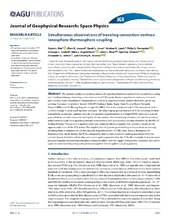Simultaneous observations of traveling convection vortices: Ionosphere-thermosphere coupling
Kim, Hyomin; Lessard, Marc R.; Jones, Sarah L.; Lynch, Kristina A.; Fernandes, Philip A.; Aruliah, Anasuya L.; Engebretson, Mark J.; Moen, Jøran Idar; Oksavik, Kjellmar; Yahnin, Alexander G.; Yeoman, Timothy K.
Peer reviewed, Journal article
Published version

View/
Date
2017-05Metadata
Show full item recordCollections
Original version
https://doi.org/10.1002/2017ja023904Abstract
We present simultaneous observations of magnetosphere-ionosphere-thermosphere coupling over Svalbard during a traveling convection vortex (TCV) event. Various spaceborne and ground-based instruments made coordinated measurements, including magnetometers, particle detectors, an all-sky camera, European Incoherent Scatter (EISCAT) Svalbard Radar, Super Dual Auroral Radar Network (SuperDARN), and SCANning Doppler Imager (SCANDI). The instruments recorded TCVs associated with a sudden change in solar wind dynamic pressure. The data display typical features of TCVs including vortical ionospheric convection patterns seen by the ground magnetometers and SuperDARN radars and auroral precipitation near the cusp observed by the all-sky camera. Simultaneously, electron and ion temperature enhancements with corresponding density increase from soft precipitation are also observed by the EISCAT Svalbard Radar. The ground magnetometers also detected electromagnetic ion cyclotron waves at the approximate time of the TCV arrival. This implies that they were generated by a temperature anisotropy resulting from a compression on the dayside magnetosphere. SCANDI data show a divergence in thermospheric winds during the TCVs, presumably due to thermospheric heating associated with the current closure linked to a field-aligned current system generated by the TCVs. We conclude that solar wind pressure impulse-related transient phenomena can affect even the upper atmospheric dynamics via current systems established by a magnetosphere-ionosphere-thermosphere coupling process.